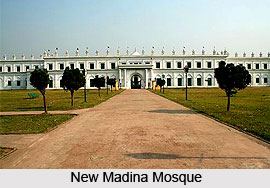 Madina Mosque belongs to the Nizamat Imambara in Murshidabad, West Bengal and had been erected by Nawab Nazim Mansur Ali Khan Feradun Jah in the year 1847 following the demolition of the ancient Imambara. The New Madina Mosque and also the Old mosque are parallel to the direction of the Hazarduari Palace. The old mosque is present on the southern side of the New Madina Mosque, which is based within the premises of the Nizamat Imambara, near the western part of the clock tower. The region is actually the burial place of the Bacchawali Tope, and is said to be a portion of Nizamart Fort Campus. Sadeq Ali Khan had supervised the construction of the Madina Mosque.
Madina Mosque belongs to the Nizamat Imambara in Murshidabad, West Bengal and had been erected by Nawab Nazim Mansur Ali Khan Feradun Jah in the year 1847 following the demolition of the ancient Imambara. The New Madina Mosque and also the Old mosque are parallel to the direction of the Hazarduari Palace. The old mosque is present on the southern side of the New Madina Mosque, which is based within the premises of the Nizamat Imambara, near the western part of the clock tower. The region is actually the burial place of the Bacchawali Tope, and is said to be a portion of Nizamart Fort Campus. Sadeq Ali Khan had supervised the construction of the Madina Mosque.
History of Madina Mosque
Nawab Siraj-Ud-Daulah had constructed the old Nizamat Imambara in the 18th century with the aide of soil imported from Mecca as its foundation. This very fact was the cause of merriment amongst the poorer section of the then society who were unable to afford a pilgrimage to the holy city of Mecca like their rich counterparts, as they could almost taste a similar experience visiting the Madina Mosque. The Imambara had been manufactured from wood and was destroyed by fire in the year 1842 and yet by another fire for the second time, during 1846, which finally led to the destruction of it`s a major part. The bigger part of the Nizamat Imambara is home to the New Madina Mosque which is placed over a raised plinth equipped with beautiful china tiles.
The foundation of Madina Mosque has been built with the help of soils brought from Karbala. In ancient times, fountains were present between the Madina Mosque and the `Memberdalan`, surrounding the shrine of Medina. The walls and arches of Madina Mosque are adorned with texts inspired by the Holy Quran. During the regime of Nawab Siraj-ud-Daulah, numerable masons used to be hired to decorate the entire structure of the mosque particularly during the festival Muharram, which is a popular annual festival of the Muslims. The second storey of Madina Mosque is richly decorated with screens, which boast of impressive patterns of people, flowers and animals which had been the work of the masons.





















